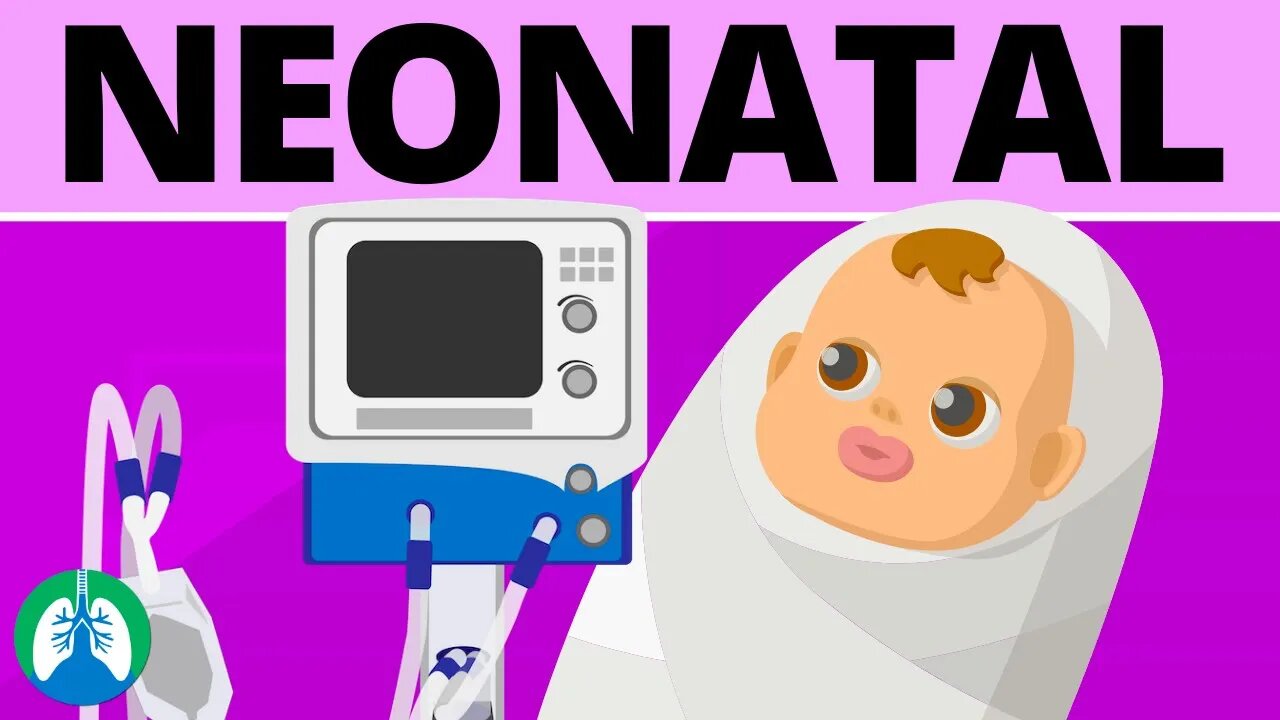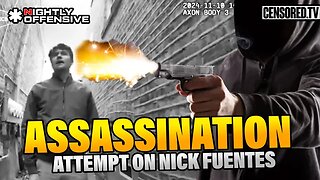Premium Only Content

Neonatal Mechanical Ventilation (Quick Medical Overview)
Neonatal Mechanical Ventilation is a requires topic for Respiratory Therapists. Watch this video for a quick overview of this topic.
💥Mechanical Ventilation in Neonates [Full Guide] ➜ ➜ ➜ https://bit.ly/2zak7af
➡️ What is Neonatal Mechanical Ventilation?
It refers to the process of providing ventilatory support for infants. This process is different than mechanical ventilation in adults because neonates are anatomically different. They also have different normal values as well as different physiological needs. Not to mention, providing mechanical ventilation in infants will require different tools, supplies, and techniques as well. This is why it’s important for Respiratory Therapists to understand the key differences between the two.
➡️ Infant Lungs vs Adult Lungs
One obvious concept to remember is that infants have much smaller lungs. This is important because it also means that they have higher airway resistance, lower lung compliance, and less surface area for gas exchange to occur. Not to mention, neonates have lower cardiovascular reserve than adults as well which makes them more susceptible to a rapid onset of respiratory distress.
➡️ Indications for Neonatal Mechanical Ventilation
If a neonatal patient can't breathe on their own, that's when mechanical ventilation is needed. But to be more specific, here are some examples of the most common indications:
▪ Apnea
▪ Bradycardia
▪ Ventilatory failure
▪ Severe hypoxemia
▪ Extreme prematurity
▪ Poor muscle tone
▪ Unresponsive to stimulus
▪ Cyanosis
▪ Low Apgar score
▪ Surfactant replacement therapy is needed
▪ Meconium present at birth
Keep in mind that there may be other indications for mechanical ventilation in neonates. These are just some of the most common examples. But once it has been decided that neonatal mechanical ventilation is needed, what's the point?
➡️ Goals of Mechanical Ventilation in Neonates:
▪ To provide adequate ventilation
▪ To provide adequate oxygenation
▪ To achieve adequate lung volumes
▪ To improve lung compliance
▪ To reduce work of breathing
▪ To limit lung injuries
➡️ Newborn Mechanical Ventilation
Keep in mind that mechanical ventilation in newborns is a very serious therapeutic measure that could be life-threatening. This is why, if possible, you could try to administer Noninvasive Ventilatory Support instead. Nasal CPAP is often a great option for neonates because it's less invasive and there are fewer complications with this type of therapy. However, it's common for the condition of an infant to continue to get worse after Nasal CPAP has been administered which means that intubation and mechanical ventilation would likely be indicated in order to provide more support.
➡️ Modes
Once mechanical ventilation has been initiated, it's important to know that Pressure-Control (PC) is the most widely used mode in neonates and pediatric patients. It allows you to preset the peak inspiratory pressure (PIP) in order to deliver a desired tidal volume which helps prevent overinflation of the tiny lungs of an infant. High-Frequency Ventilation (HFV) is often used in neonates as well and is effective because it provides small tidal volumes at a very fast frequency. This also helps prevent barotrauma as well. Some of this stuff can be very complex, so we're going to break it down into much more detail in separate videos.
💥Mechanical Ventilation in Neonates [Full Guide] ➜ ➜ ➜ https://bit.ly/2zak7af
—————
📗 BEST STUDY GUIDES FOR YOU
▪ TMC Test Bank 👉 http://bit.ly/2IGeqSu
▪ Hacking the TMC Exam 👉 http://bit.ly/2XBc8do
▪ TMC Exam Bundle (Save $) 👉 https://bit.ly/34pqEsV
▪ Daily TMC Practice Questions 👉 http://bit.ly/2NnXh3C
💙MORE FROM RTZ
▪ Free TMC Practice Exam 👉 http://bit.ly/2XlwASL
▪ Free RRT Cheat Sheet 👉 http://bit.ly/2IbmOKB
▪ Resources for RT's 👉 http://bit.ly/2WVV5qo
▪ Testimonials 👉 http://bit.ly/2x7b5Gl
🌐FOLLOW US
▪ Instagram 👉 http://bit.ly/2FhF0jV
▪ Twitter 👉 http://bit.ly/2ZsS6T1
▪ Facebook 👉 http://bit.ly/2MSEejt
▪ Pinterest 👉 http://bit.ly/2ZwVLPw
🚑MEDICAL DISCLAIMER
Medicine and Respiratory Therapy are continuously changing practices. The information in this video is for educational and entertainment purposes only. For medical advice, please consult with a physician or qualified medical professional.
💡AFFILIATE DISCLAIMER
This description contains affiliate links. If you decide to purchase a product through one of them, we receive a small commission at no cost to you.
—————
⏰TIMESTAMPS
0:00 - Intro
0:28 - What is Neonatal Mechanical Ventilation?
1:05 - Infant Lungs vs Adult Lungs
1:34 - Indications for Neonatal Mechanical Ventilation
2:28 - Goals of Mechanical Ventilation in Neonates
2:48 - Newborn Mechanical Ventilation
3:27 - Modes
—————
🖼CREDIT FOR MUSIC AND GRAPHICS:
▪ Music provided by https://audiojungle.net/
▪ Graphics: www.canva.com
▪ Graphics: www.freevector.com
▪ Graphics: www.vecteezy.com
▪ Graphics: www.pngtree.com
#RespiratoryTherapy #MechanicalVentilation #Neonatal
-
 3:17
3:17
Respiratory Therapy Zone
1 year agoWhat is Silicosis? (EXPLAINED) 🫁
415 -
 43:27
43:27
barstoolsports
10 hours agoOld Dog Bites Back | Surviving Barstool S4 Ep. 9
96.7K3 -
 5:13:04
5:13:04
Right Side Broadcasting Network
7 days agoLIVE REPLAY: TPUSA's America Fest Conference: Day One - 12/19/24
157K27 -
 1:06:01
1:06:01
Man in America
1 day agoPfizer Has Been Caught RED HANDED w/ Dr. Chris Flowers
43.3K11 -
 2:24:15
2:24:15
Slightly Offensive
8 hours ago $11.78 earnedAttempted ASSASSINATION of Nick J Fuentes LEAVES 1 DEAD! | Guest: Mel K & Breanna Morello
35.7K21 -
 1:43:08
1:43:08
Roseanne Barr
8 hours ago $20.25 earned"Ain't Nobody Good" with Jesse Lee Peterson | The Roseanne Barr Podcast #79
72.9K32 -

The StoneZONE with Roger Stone
5 hours agoTrump Should Sue Billionaire Governor JB Pritzker for Calling Him a Rapist | The StoneZONE
45.2K5 -
 1:36:58
1:36:58
Flyover Conservatives
23 hours agoAmerica’s Psychiatrist Speaks Out: Are We Greenlighting Violence? - Dr. Carole Lieberman | FOC Show
29.1K5 -
 DVR
DVR
LittleSaltyBear
7 hours ago $2.57 earnedNecromancing Path of Exile 2 4K
27.3K5 -
 3:51:34
3:51:34
Akademiks
6 hours agoJay Z War against Diddy Accuser Lawyer GOES CRAZY! Lil Baby Speaks OUT! Cardi v Offset? Bhad Bhabie?
83.4K6